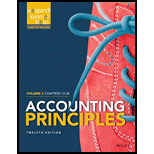
Concept explainers
Earnings per Share: Earnings per share reflect the amount earned or lost on each outstanding common equity share. It is widely used to evaluate the performance of a business.
Price/Earnings Ratio: The price/earnings ratio shows the market value of the amount invested to earn $1 by a company. It is major tool to be used by investors before the decisions related to investments in a company.
Payout Ratio: After the calculation of earnings per share, companies declare the amount to be paid to common shareholders out of those earnings. This portion of earnings per share declared to be paid as dividends is measure by payout ratio.
Times Interest Earned: Measure to evaluate the net income that can be used for interest payment on debt of a company is called times interest earned. It is a part of solvency ratios.
To compute: (a) Earnings per share (b) Price/earnings ratio (c) Payout ratio (d) Times interest earned of S Company for 2017.
Want to see the full answer?
Check out a sample textbook solution
Chapter 18 Solutions
Accounting Principles, Volume 2: Chapters 13 - 26
- I am looking for the correct answer to this general accounting question with appropriate explanations.arrow_forwardValor Systems is considering a project that will produce incremental annual sales of $320,000 and increase cash expenses by $205,000. If the project is implemented, taxes will increase from $31,000 to $37,000. The company is debt-free. What is the amount of the operating cash flow using the top-down approach? Need helparrow_forwardanswer this without using Chatgtp or AIarrow_forward
- Simba Pets uses the perpetual inventory system. At the beginning of the quarter, Simba Pets has $42,000 in inventory. During the quarter, the company purchased $9,200 of new inventory from a vendor, returned $1,500 of inventory to the vendor, and took advantage of discounts from the vendor of $300. At the end of the quarter, the balance in inventory is $34,500. What is the cost of goods sold? A. $15,500 B. $14,900 C. $13,500 D. $16,200arrow_forwardI need help solving this general accounting question with the proper methodology.arrow_forwardCan you solve this general accounting problem with appropriate steps and explanations?arrow_forward

 AccountingAccountingISBN:9781337272094Author:WARREN, Carl S., Reeve, James M., Duchac, Jonathan E.Publisher:Cengage Learning,
AccountingAccountingISBN:9781337272094Author:WARREN, Carl S., Reeve, James M., Duchac, Jonathan E.Publisher:Cengage Learning, Accounting Information SystemsAccountingISBN:9781337619202Author:Hall, James A.Publisher:Cengage Learning,
Accounting Information SystemsAccountingISBN:9781337619202Author:Hall, James A.Publisher:Cengage Learning, Horngren's Cost Accounting: A Managerial Emphasis...AccountingISBN:9780134475585Author:Srikant M. Datar, Madhav V. RajanPublisher:PEARSON
Horngren's Cost Accounting: A Managerial Emphasis...AccountingISBN:9780134475585Author:Srikant M. Datar, Madhav V. RajanPublisher:PEARSON Intermediate AccountingAccountingISBN:9781259722660Author:J. David Spiceland, Mark W. Nelson, Wayne M ThomasPublisher:McGraw-Hill Education
Intermediate AccountingAccountingISBN:9781259722660Author:J. David Spiceland, Mark W. Nelson, Wayne M ThomasPublisher:McGraw-Hill Education Financial and Managerial AccountingAccountingISBN:9781259726705Author:John J Wild, Ken W. Shaw, Barbara Chiappetta Fundamental Accounting PrinciplesPublisher:McGraw-Hill Education
Financial and Managerial AccountingAccountingISBN:9781259726705Author:John J Wild, Ken W. Shaw, Barbara Chiappetta Fundamental Accounting PrinciplesPublisher:McGraw-Hill Education





